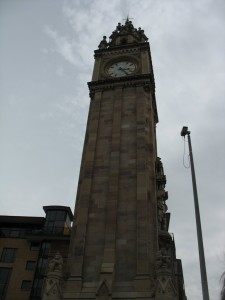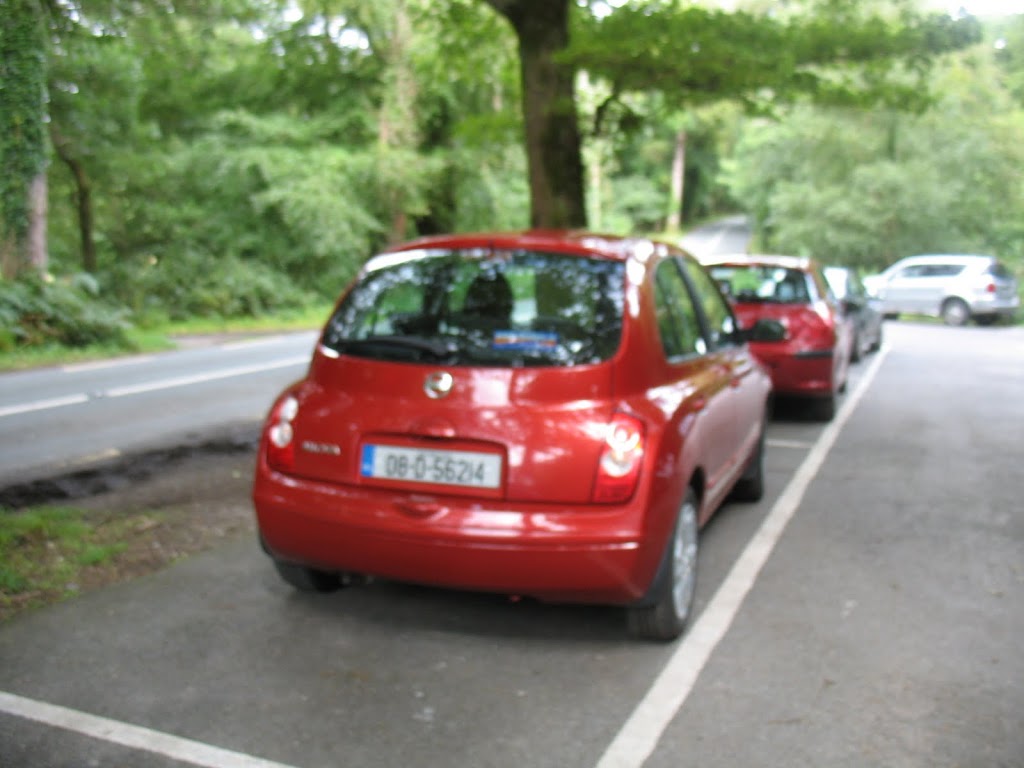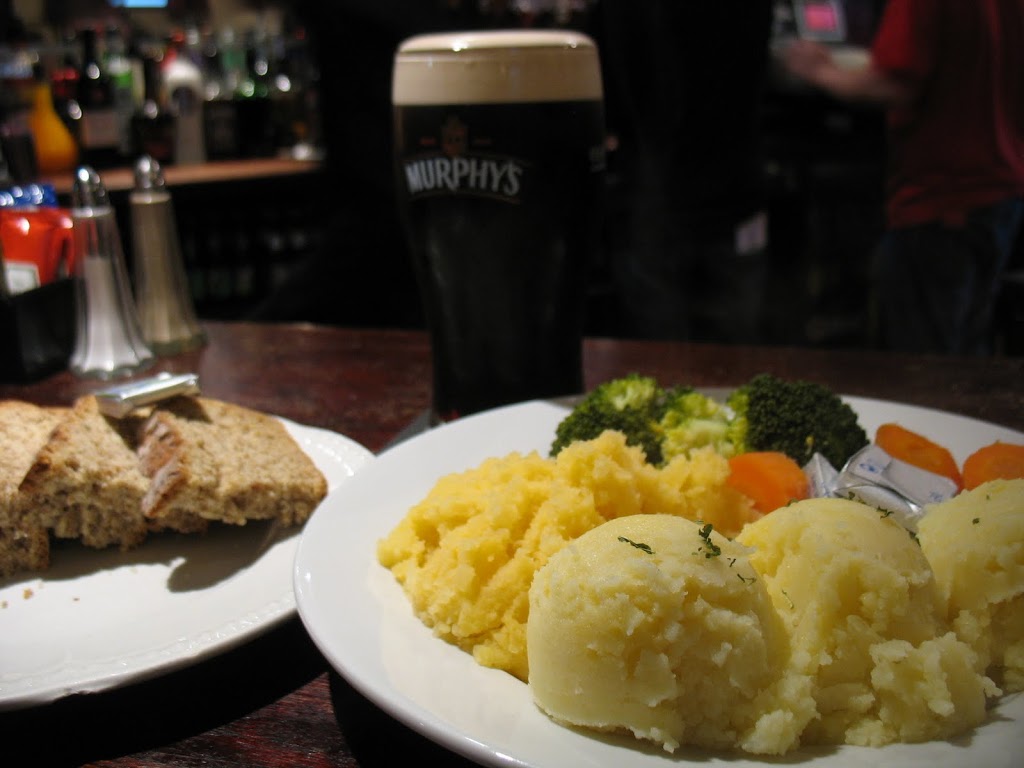 in addition to the very well-preserved Trim Castle (the top of which this photo was taken), there is a very well-preserved Barbican gate. each side of the gate served as a different location during the filming of Braveheart. one side was York, and I forget the name of the other location.
in addition to the very well-preserved Trim Castle (the top of which this photo was taken), there is a very well-preserved Barbican gate. each side of the gate served as a different location during the filming of Braveheart. one side was York, and I forget the name of the other location.
Barbican gates were designed to give archers an advantage over advancing troops and this one had two drawbridges.
Galway Cathedral
 officially named the Cathedral of Our Lady Assumed into Heaven and St. Nicholas, construction on the Galway Cathedral began in 1958 and it was consecrated in 1965. the pews are mahogany and hold up to 2,000 worshipers in a service. the floor is green Connemara marble, and the “acoustically correct” cedar ceiling comes from Canada. one of the stained glass windows depicts the ‘modern’ holy family — Mary is knitting while Jesus and Joseph make a cup of tea.
officially named the Cathedral of Our Lady Assumed into Heaven and St. Nicholas, construction on the Galway Cathedral began in 1958 and it was consecrated in 1965. the pews are mahogany and hold up to 2,000 worshipers in a service. the floor is green Connemara marble, and the “acoustically correct” cedar ceiling comes from Canada. one of the stained glass windows depicts the ‘modern’ holy family — Mary is knitting while Jesus and Joseph make a cup of tea.
farm life!
 making friends with sheep and donkeys at Dunbeg ring fort on the Dingle peninsula.
making friends with sheep and donkeys at Dunbeg ring fort on the Dingle peninsula.
there are sheep everywhere. surprise surprise. the Dingle peninsula alone has a sheep population of 500,000, tended by a human population of 10,000. they graze most anywhere, including property owned by the Office of Public Works.


Torc Waterfall
 after lunch in Killarney, we decided to drive around the Ring of Kerry. this resulted in some very scary moments facing down oncoming coaches, but it also provided us with two spectacular destinations, the first of which was Torc Waterfall. the Owengarriff River flows through the Friar’s Glen from the “Devil’s Punch Bowl” and falls 18 metres. (the first picture is at the top of the falls; the second, at the bottom.) initially we didn’t intend to go all the way to the top, but it’s only 70 vertical feet and took us about 15 minutes to get to the top — very much worth the time effort.
after lunch in Killarney, we decided to drive around the Ring of Kerry. this resulted in some very scary moments facing down oncoming coaches, but it also provided us with two spectacular destinations, the first of which was Torc Waterfall. the Owengarriff River flows through the Friar’s Glen from the “Devil’s Punch Bowl” and falls 18 metres. (the first picture is at the top of the falls; the second, at the bottom.) initially we didn’t intend to go all the way to the top, but it’s only 70 vertical feet and took us about 15 minutes to get to the top — very much worth the time effort.
the Kerry Way crosses across the top of the waterfall. there are signposted walks all over Ireland, and this is one of the longest at 215 kilometers. it roughly follows the driving route around the Ring of Kerry, and begins and ends in Killarney. we didn’t see anyone who looked like they were doing the hike, but we did our trek rather later in the day (about 3 pm)
another popular attraction near Muckross House (just down the road from the Torc Waterfall) are the “jaunting cars”, or horse-drawn buggies that will take you through the gardens of Muckross House and along this stretch of road. mostly, it was a lot of fun to say “hey, look, it’s a jaunting car.”
Cong
 the town of Cong straddles the Counties of Mayo and Galway, and is nestled between the Lough Corrib and Lough Mask. apparently it is known for the underground streams that connect the two, as well as for its fishing. the Abbey, the ruins of which are seen in the first photo, is reputed to be where Rory O’Connor, the last High King of Ireland, died.
the town of Cong straddles the Counties of Mayo and Galway, and is nestled between the Lough Corrib and Lough Mask. apparently it is known for the underground streams that connect the two, as well as for its fishing. the Abbey, the ruins of which are seen in the first photo, is reputed to be where Rory O’Connor, the last High King of Ireland, died.
nearby, squatting over the river, is the Monk’s Fishing Hut, seen in the second photo. there’s a gap in the floor, through which the monks could drop a net to snag some fish. it was built sometime inte 15th or 16th century.

Hotel Europa
vehicular travel
 driving a manual transmission on the other side of the road was a great adventure in itself. apart from the motorways and major arterial roads designed to handle lots and lots of coach traffic, everything is two lanes. and by two lanes, i mean wide enough to accommodate two cars smaller than the one that i drive now (which is considered compact), and nothing else. no hard shoulder, hedgerows everywhere so if you’re not in open fields, like in parts of Co. Kerry or Co. Clare, then you’ve no idea what is coming around the bend. makes for exciting driving, that’s for sure.
driving a manual transmission on the other side of the road was a great adventure in itself. apart from the motorways and major arterial roads designed to handle lots and lots of coach traffic, everything is two lanes. and by two lanes, i mean wide enough to accommodate two cars smaller than the one that i drive now (which is considered compact), and nothing else. no hard shoulder, hedgerows everywhere so if you’re not in open fields, like in parts of Co. Kerry or Co. Clare, then you’ve no idea what is coming around the bend. makes for exciting driving, that’s for sure.
 when i didn’t have a car, i availed myself of the public transportation systems, local, regional, and international. for the most part, that meant Bus Eireann, the national bus service that connects pretty much everything in the Republic of Ireland. during the tourist season they run a bus from Drogheda to Bru na Boinne — very handy. round trip to central Dublin took about 40 minutes, and out to the beach at Bettystown in about 20. bus stations varied in size and amenaties — Busaras in Dublin, and Europa in Belfast are large and bustling, no surprise. and play host to all kinds of people. the one in Drogheda is mostly just a building to in which to shelter in colder weather. when i went through on my way from Belfast to Cork, our bus was heavliy subscribed (it was a Sunday), so they split us in to two groups: one heading to Cork city and one heading to points in between. it was there that i managed to capture a photo of a hairstyle that seemed to be quite the rage, in Belfast at least. not quite mohawk, not quite … i don’t even know, but certainly special!
when i didn’t have a car, i availed myself of the public transportation systems, local, regional, and international. for the most part, that meant Bus Eireann, the national bus service that connects pretty much everything in the Republic of Ireland. during the tourist season they run a bus from Drogheda to Bru na Boinne — very handy. round trip to central Dublin took about 40 minutes, and out to the beach at Bettystown in about 20. bus stations varied in size and amenaties — Busaras in Dublin, and Europa in Belfast are large and bustling, no surprise. and play host to all kinds of people. the one in Drogheda is mostly just a building to in which to shelter in colder weather. when i went through on my way from Belfast to Cork, our bus was heavliy subscribed (it was a Sunday), so they split us in to two groups: one heading to Cork city and one heading to points in between. it was there that i managed to capture a photo of a hairstyle that seemed to be quite the rage, in Belfast at least. not quite mohawk, not quite … i don’t even know, but certainly special!
pub grub
the black stuff
 there’s a knack to pouring Guinness. doing it properly requires a double pour, and takes a couple of minutes to settle. the first 3/4 of the pour goes in to the glass at a 45 degree angle. then you set it aside while it settles — the Guinness cascade. it is wonderfully fascinating to watch. once the black stuff settles, the remainder is poured slowly until the head forms a slight dome over the top of the glass (or at least it should … i had a pint or two that didn’t quite suffice).
there’s a knack to pouring Guinness. doing it properly requires a double pour, and takes a couple of minutes to settle. the first 3/4 of the pour goes in to the glass at a 45 degree angle. then you set it aside while it settles — the Guinness cascade. it is wonderfully fascinating to watch. once the black stuff settles, the remainder is poured slowly until the head forms a slight dome over the top of the glass (or at least it should … i had a pint or two that didn’t quite suffice).
and despite being dark, a pint of Guinness has fewer calories than skim milk or orange juice. the Guinness diet works for me!
Albert Memorial Clock Tower

the Albert Memorial Clock Tower in Belfast honors the Prince Consort of Queen Victoria (like every other Victorian-era monument anywhere in the British Empire). completed in 1870, it was built on wooden piles on marshy ground over the River Farset just before it joins the River Lagan. consequently, it leans four feet, which you can’t quite tell from these pictures. at one point, the base of the tower was quite popular for a certain character of women to offer their wares. it’s a straight shot down to the River Lagan, over the weir to the docks, and a large plaza to the west next to the customs house. there’s a large fountain in the plaza to the east of the tower (the kind that shoots water up at different heights in different patterns) and as we walked by there were a pair of sisters playing in the water, tempting fate to get a soaking.















